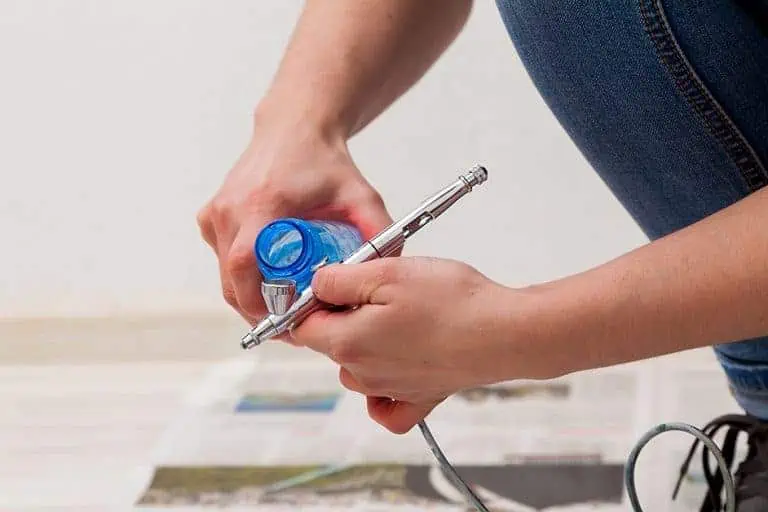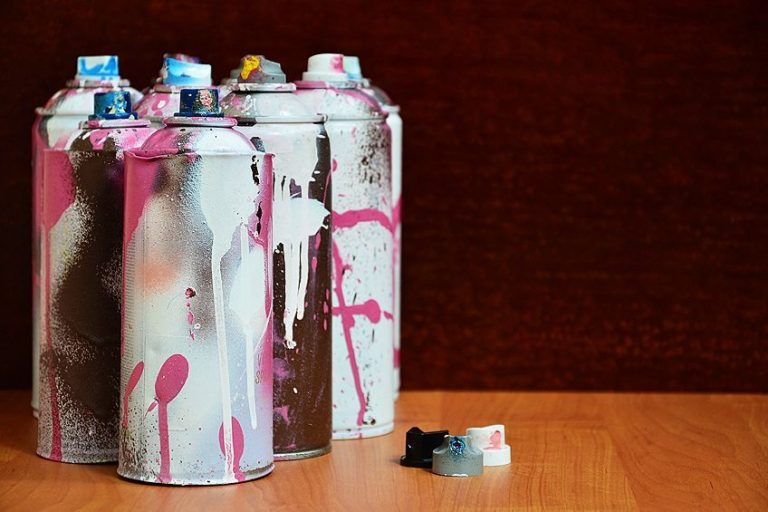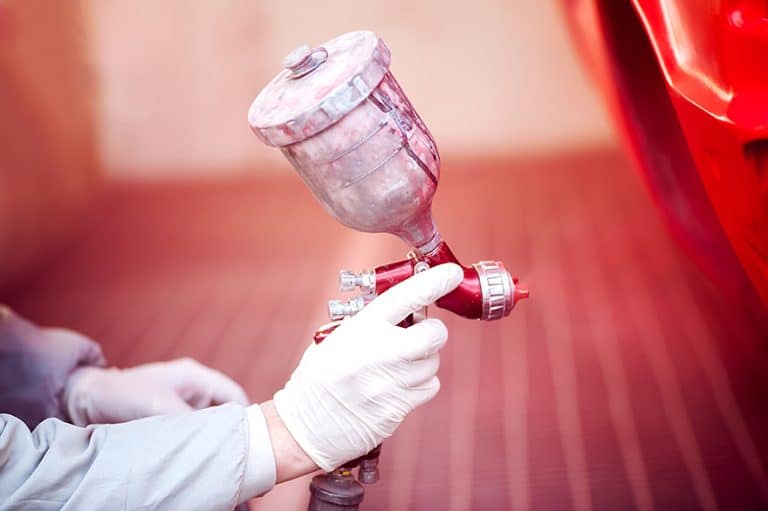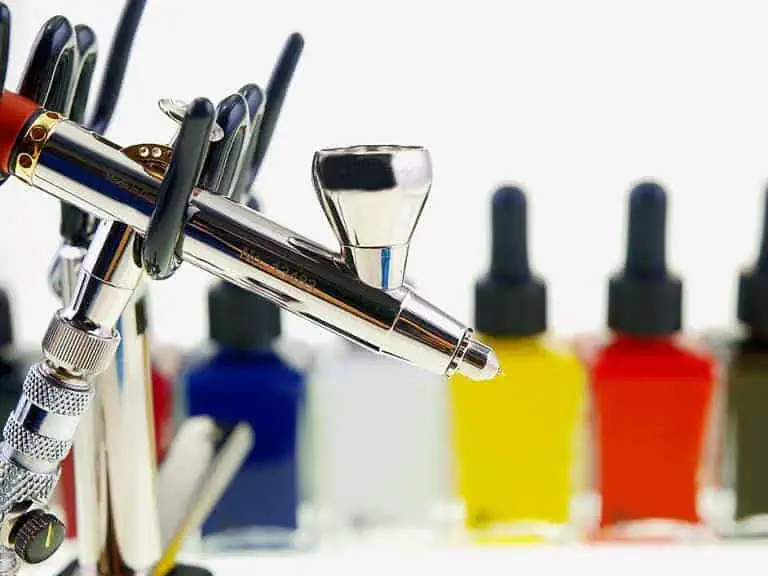Should you Wear a Respirator for Spray Painting? Full Guide
This post may contain affiliate links. We may earn a small commission from purchases made through them, at no additional cost to you.
At some stage in our lives, we have all done some home improvements or various jobs in and around the house. Some of these have involved exposure to dangerous, harmful toxins and chemicals. The job may have been painting your house or furniture, spraying pesticides in the garden, using adhesives or caustic products, or sanding which causes excessive dust. All of this can be harmful to your overall health and you need to wear protective equipment to protect you from inhaling any harmful substances. In this article, we will be helping you to understand the need for this equipment and also what type of equipment will be best suited for your particular project.
Table of Contents
- 1 What is the Benefit of Wearing a Respirator Mask?
- 2 How Does a Respirator Mask Work?
- 3 Type of Painters Masks
- 4 Type of Respirator Filters
- 5 What to Bear in Mind When Purchasing the Best Paint Respirator?
- 6 What is the Best Spray Painting Respirator Mask?
- 7 Pros and Cons of Using Paint Respirator Masks
- 8 Some Safety Tips When Using Your Paint Respirator Mask
- 9 How important is the Maintenance of Your Respirator?
- 10 Frequently Asked Questions
What is the Benefit of Wearing a Respirator Mask?
Life is very precious and short, and there is no price tag that you can put on your health. So, keeping safe and healthy at your place of work or in your home is of vital importance. When needed, you must protect yourself from harmful gases, fumes, or dust that may be fatal if inhaled. Otherwise, it may cause things like asthma, rashes, allergies, and other very serious breathing problems. The best way to do this is to wear a fume mask when engaged in activities that emit harmful chemicals, dust, and fumes. This equipment will protect your respiratory system like your mouth, nasal cavities, lungs, and throat.
How Does a Respirator Mask Work?
The respirator mask works by creating a seal around your nose, mouth, or even your whole face, by filtering out any harmful fumes before they can enter your respiratory tract. They can also help by preventing you from breathing in any dust particles that may cause irritation, lung problems, and sometimes even death. Some of the spray paint masks are so designed that they offer you full-face protection and this will then also include your eyes.
The main purpose of the respirator is to allow you to breathe in a normal and safe manner when handling potentially dangerous and harmful chemicals and materials. The fume mask filters out all of those harmful and dangerous substances before they can get into your bloodstream or lungs, allowing you to breathe in safe and clean air. To be able to understand it better, consider for a moment how scuba gear works in allowing you to breathe in the air instead of water, the same principle applies with a fume mask.
There are different types of spray paint masks, each designed for a specific purpose. Many spray paint respirators contain filter elements some have paper, pads, canisters, and others have a device that captures those harmful particles, keeping you healthy. Its objective is similar to an air purifier that filters out any solvents, dust particles, contaminants, or any harsh elements in the surrounding air, giving you clean air to breathe in.
Take note that all spray paint respirators have limitations, and you need to be aware of the capabilities of each respirator for painting mask, to give you the right protection you need for your particular situation. Also, remember that you can only wear a respirator under specific conditions and need to wear it correctly by attaching the cartridges and filters properly. For example, if you want to use a half-mask respirator, it would be best to use organic vapor cartridges and pre-filters for the right protection.

Type of Painters Masks
Just like many products that people are buying, there are usually numerous types of respirator for painting masks available and it is a daunting task to know which one to buy. So, we will now try to help you in your choice of an effective respirator. The first thing to consider is what type of job or task you want to do, like painting, using pesticides, cleaning using dangerous chemicals, or just a small DIY project or craft.
No matter what your job is, if it involves harmful substances then you need to wear a protective mask before you begin to tackle the job. Remember, not all of the respirator masks are the same, there are different masks for different jobs, and they are all rated for efficiency. For the average homeowner that does jobs around the house or in the workshop, all you will need is a particulate filter (or dust mask) or a cartridge respirator. Here are the different types of respirator masks you can purchase.
Negative or Positive Pressure Respirator Masks
What this means is that the air supply you breathe in is either automated or natural. With the negative pressure mask, you the wearer, create your own airflow by breathing in the filtered natural air, while the positive pressure mask has a blower or separate air supply that creates your clean air. The positive pressure masks are not used often when spray painting, but the negative pressure masks are specially designed for spray painters and DIY enthusiasts. These masks are supplied in full-face, half-face, reusable masks, and disposable or single-use masks.
Half-Face Respirator Mask
The half-face respirator is exactly what it says, it covers half of your face your mouth, and your nose. There is also a strap attached to it that encircles the back of your head. One main advantage of the half-face respirator is that it offers more comfort. With the half-face mask, you can wear it underneath a welding helmet, but you will have to buy yourself some safety goggles to protect your eyes. One added benefit is that they are reusable and all you need to do, is replace the cartridge and you can use it again.
These types of respirators for painting are suitable for jobs that do not need eye protection. However, it does make provision for you to wear protective goggles as well, and the half-face respirators are also cheaper than the full-face respirators.
Full-Face Respirator Mask
The full-face respirator, on the other hand, offers you full coverage of your whole face. This means it covers your mouth, nose as well as giving protection for your eyes. This dual function protection not only protects your eyes but also protects your respiratory system and lungs. The eye protection it offers is far superior to that offered to you by ordinary safety goggles. It also has the added advantage of being able to replace the cartridge and reuse them again.
One disadvantage of this type of respirator is that it tends to steam up when used for long periods, which is why they are fitted with a cool flow valve that can release all the accumulated moisture, allowing you to see clearly. This type of respirator is also bulkier than the half-face respirator and costs more. This type of respirator is suitable for applications such as chemical clean-ups, furnace operations, spray painting, sawing, and sanding, grinding, and chemical handling. People who wear prescription glasses prefer to use the half-face mask, as it is easier to work with.

Air Purifying Respirator (APR) Mask
The APR mask filters out any dust particles, solvents, or isocyanates (chemicals) that are found in the air around you. However, it will only work if you wear the mask correctly with the right cartridge. The correct cartridge for filtering out solvents is organic vapor cartridges. They are also equipped with HEPA (High-efficiency particulate air) filters that help to filter out dust particles. If you are intending to do a painting job, then the APR mask is the best choice with an organic vapor cartridge and a dust pre-filter attached.
Remember, it is vital that you change the cartridges and filters regularly, say once a week, if you are painting every day, or whenever you start to smell an unwanted odor or experience difficulty in breathing properly through the respirator. The APR mask is supplied in full-face and half-face respirators.
Supplied Air Respirator (SAR) Mask
The SAR masks are not common when it comes to spray painting but were originally designed for use in the military to filter out the mustard and tear gas. The air that you breathe in is supplied from a tank as part of the respirator and is not ambient filtered air. It is not very often that you find a SAR mask in half-face, as it was specially designed to cover the whole face and protect all of your mucous membranes.
Powered Air Purifying Respirator (PAPR) Mask
This mask is similar to the APR mask and works through filtered air through cartridges, but pumps filtered air to your mask from a pack that is worn on your back and can also be worn with a loose-fitting hood. If you are one of those people who have a beard, then this mask will still give you maximum protection. The great advantage of the PAPR mask is that it provides you with freedom of movement and allows you to clean your spray gun or mix your paint without having to remove the mask, making it very convenient to use.
Disposable Particulate or Dust Mask
This type of mask is referred to as an air-purifying respirator and is effective in filtering out small particles in the air. This type of mask often comes with a label indicating its level of protection, which may be an N95 or P95 filter. This indicates it can eliminate 95 percent of the small particles in the air, and some of them also have an N100 label.
The disadvantage of this type of mask is that they do not fit tightly on your face as a full or half mask does, limiting your protection. They are also designed to be used only once and are not reusable, which may be a good idea if you only use them occasionally. Their filtration system is not very effective and they cannot be used to filter toxic chemicals, but are better suited in filtering out dust particles.
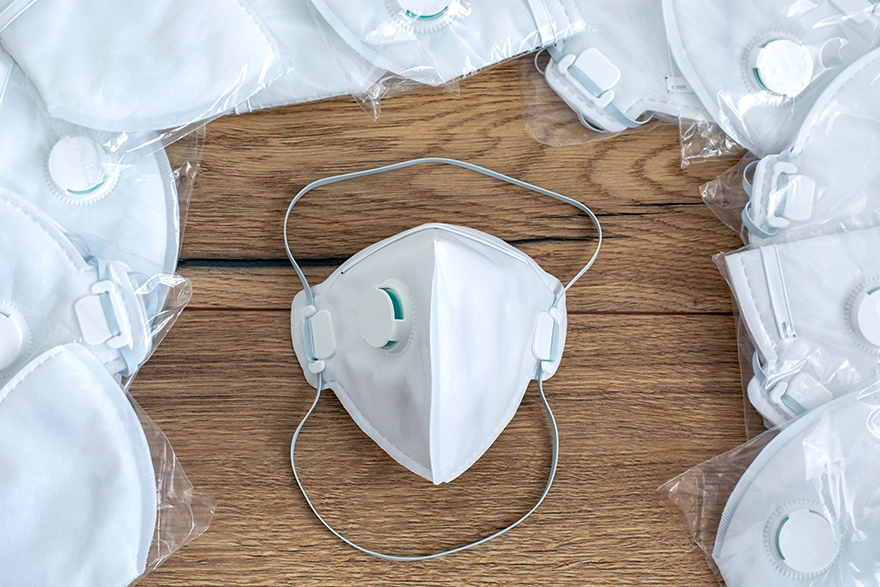
Type of Respirator Filters
Now that you have gone through the choices of what type of respirator you will need for your project, you now need to decide what type of filter you need. You first need to decide what chemicals or impurities you want your respirator to filter out. You can then decide if a particle or cartridge filter will do the job for you. If your job involves organic vapors, ammonia, or acid gasses, then you will need to use a chemical cartridge. If it involves working with pesticides, pollen, fibers, mold, asbestos, allergens, and so on, then the particle filters are the right ones to use.
Particle Filters
These filters come with disposable masks; however, they can be reused if you insert a replicable filter and not a disposable one. The particle filters filter out substances like mists, dust, and liquids but they are designed to filter out odors, gasses, or vapors. The National Institute of Occupational Safety and Health (NIOSH) has categorized these filters into three groups with a letter of the alphabet followed by a number, N, R, or P, indicating the resistance of the filter to filtration of oil-based aerosols like lubricants, glycerine, cutting fluids and so on. The filters resistance is indicated as below:
- N: does not provide oil-proof function
- R: resistant to oil for up to eight hours
- P: oil proof over eight hours
This is further clarified in the short table shown below, indicating the resistance to oil and the minimum efficiency level for the filters:
| Respirator Class | Minimum efficiency level |
| N95, R95, P95 | 95 percent |
| N99, R99, P99 | 99 percent |
| N100, R100, P100 | 99,97 percent |
Chemical Cartridges
Since these filters are so fine, they will not give you any protection from small particles in the air but are specially designed to filter out paint fumes and acetone. They will also block out harmful gasses and vapors such as sulfur, chloride, chlorine, methane, and many more.
These types of respirators for painting and sanding are equipped with a carbon filtering material filter that prevents the vapors and gasses from entering the mask. These filters are also replaceable. It is sealed on all sides, giving you perfect protection and not allowing any gasses or vapors to enter the mask. These masks are supplied in two forms; the half-face mask and the full-face mask, which covers your whole face, ensuring complete protection.
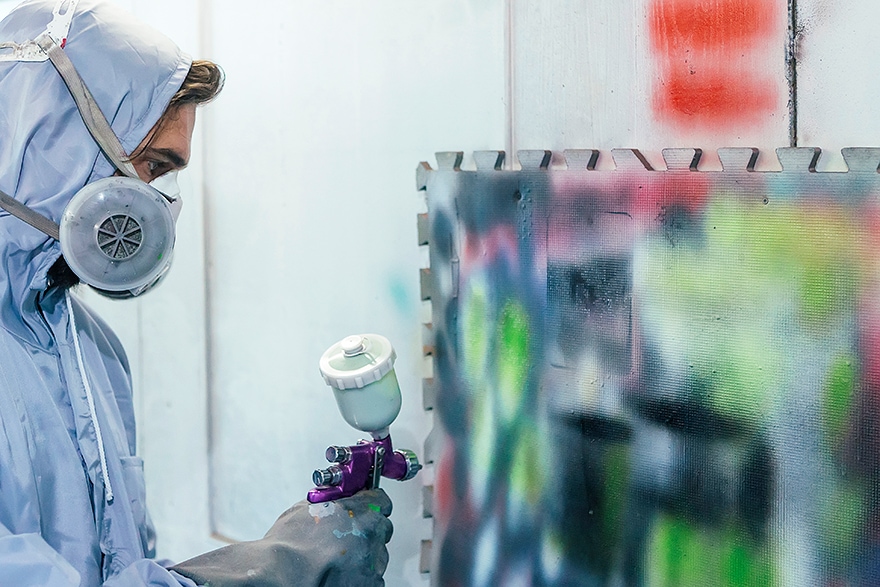
Combination Cartridges
These dual cartridges have both carbon filters as well as particle filters, which can block out any harmful particles in the air as well as vapors and gasses. The first carbon filter filters out the gasses and vapors, while the second particle filter will filter out any particles in the air like mold, spores, mildew, paint, or pollen.
What to Bear in Mind When Purchasing the Best Paint Respirator?
Now it is time to go and buy your respirator, you have to decide on what type to buy, but before you do, there are a few things to consider which will make your purchase so much easier. You need to understand what type of filtration system you want; will it block out all of the unnecessary vapors, chemicals, and dust? You also want to consider how the mask is going to fit on your face, as you may be wearing it for quite a long time. This will include taking note of facial hair and also if you wear prescription glasses, as all of this will affect the seal of the mask around your face. Let us now look at some of these factors that need to be considered before you go out to buy your painters mask.
Filtering Ability
You need to take into account the specific amount of filtration your respirator can filter, and then buy one that gives you the maximum protection for the particular work you are going to do. This is particularly important when it comes to filtering toxic gases or other particles in the air that could be harmful to you.
Respirator Filters
The filters of the respirator are especially important, especially when it comes to spray painting. You need to establish if the built-in filters alone can filter out the chemicals, contaminants, and allergens that you are going to expose yourself to. The integrated filters are gas and vapor filters that will help with paint fumes, but they do not protect you from dust and other particles in the air. So, if you are intending to do a lot of sanding and painting, then it is recommended you buy a dual or combination cartridge that can handle particles as well as vapors. On the other hand, you may choose the particle filter that can purify the air and filter out large particles but will not protect you from vapors and gases. This is one of the decisions you need to make before you go to buy your respirator.
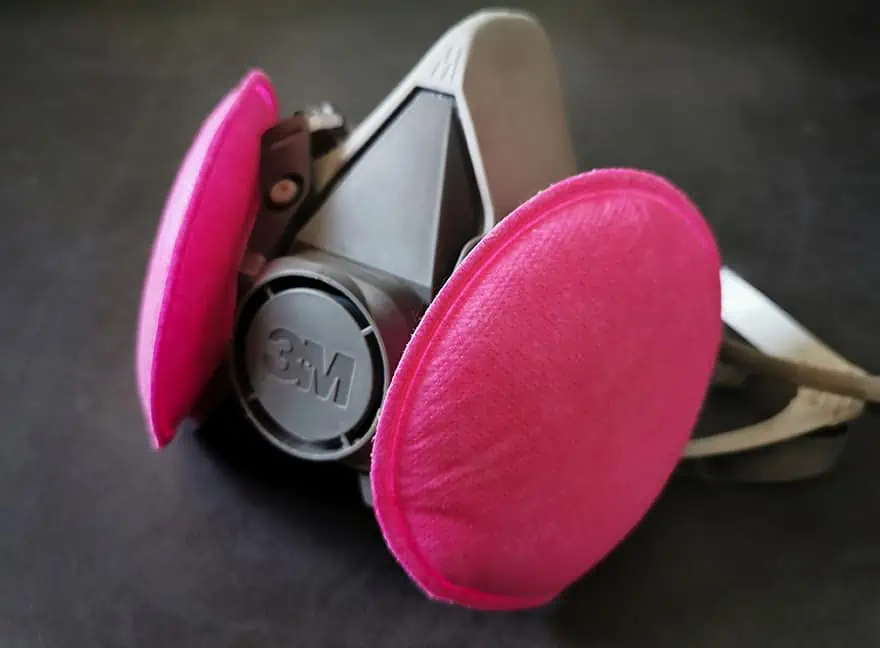
National Institute for Occupational Safety and Health Approval
There are so many types of products out there that claim they comply, but you need to make sure that the product you buy has the National Institute for Occupational Safety and Health certification. The filters with this rating are regulated, tested, and approved, and guarantee to protect you from hazardous substances like toxic gases, fumes, chemicals and can keep you safe.
Reusability
We are apt to think it is a lot easier to buy a disposable mask, and once you use it, you just throw it away. However, remember these types of filters are not effective when it comes to vapors and fumes. Try to buy a respirator that is reusable and has replaceable filters and cartridges, but you need to be very careful that you change them regularly or you might find yourself breathing in those toxic fumes. You need to make a point of abiding by the maintenance instructions for your respirator and be aware of the length of time they remain reusable.
Comfort
Comfort is particularly important, as you will probably be wearing the mask for some length of time every day and it should be comfortable enough to last for 8 to 12 hours. This means your eyes must always have the maximum field of view and be able to focus properly on your task. Some of the masks are equipped with coverings that make the contact with the nose softer. You should never experience difficulty breathing properly. Also, there is the question of weight, you should buy one that is fairly lightweight. For example, weighing less than a pound but does not compromise the safety specifications.
Size and Fit
The size needs to be correct, which means not too small and not too big, both of which will compromise your safety. All the respirators for painters have adjustable straps to help keep the mask tightly sealed around your face. You need to ensure that the mask seals properly and does not cut off any circulation or allow air to enter anywhere else.
What is the Best Spray Painting Respirator Mask?
To have the best respirator mask for your spray painting project is of paramount importance, as they offer protection to your lungs from paint particles and fumes. Not all paint spray respirators are the same, so you must know and understand what you are going to use them for. For interior or exterior painting, you need to use a gas respirator, but for light mist or dust, a particle filter should be all you need.
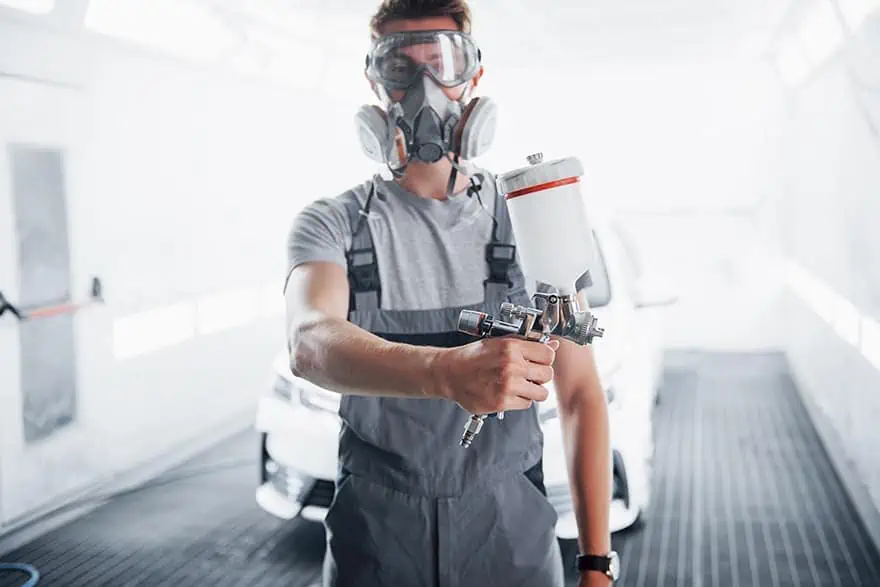
Pros and Cons of Using Paint Respirator Masks
We have discussed the various types of respirators, filters, and cartridges that are available, but what are the advantages and disadvantages when using these various types. If we can understand the pros and cons of each type better, it will give us greater peace of mind when buying the right one for our project. The main object for wearing a respirator is for the protection of your lungs, skin, and eyes, so let us now consider each one in turn as to its pros and cons.
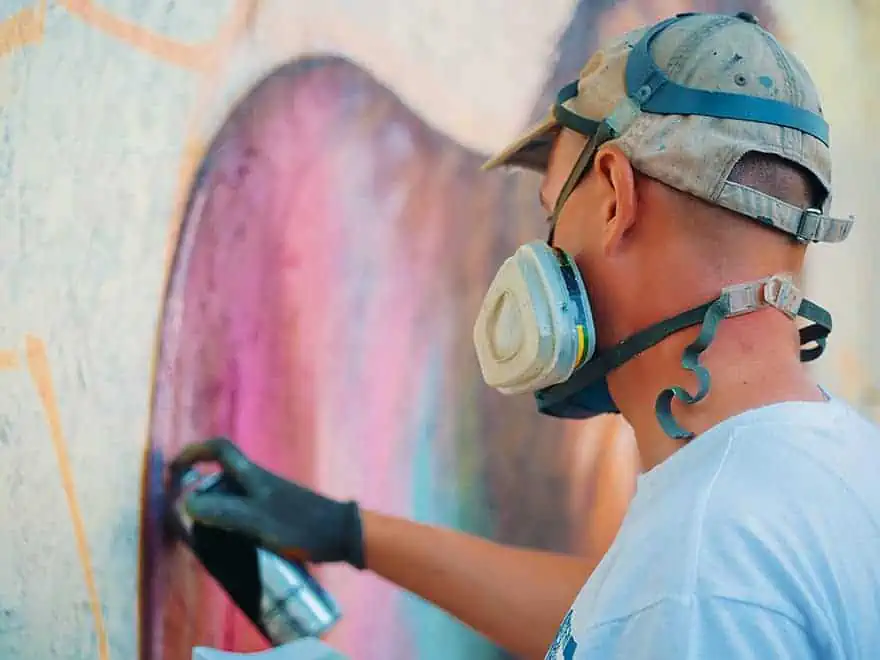
Disposable Particle or Dust Mask
These disposable types of respirators have been certified by the NIOSH (National Institute for Occupational Safety and Health) with the letters N, R, and P and you can buy them with or without exhalation valves. Most of the manufacturers have produced them in different sizes making them available for children to adults.
PROS
- Lightweight
- Comfortable to wear
- No maintenance or cleaning
- No effect on mobility
CONS
- Is not guaranteed to keep all contaminated air out
- Cannot be used effectively with people having beards
- No eye protection
- No protection against vapors and gasses
- Some types do not have adjustable head straps
- Respirators with exhalation valves cannot be used in clean and sterile environments
Half-Face Respirator Mask
This type of respirator is supplied with single or also dual filters, which are made from the same material as the disposable dust masks. Most of the manufacturers produce them in one size only, or medium and large. When using this mask, you can also make use of a face shield for added protection.
PROS
- Lightweight
- No effect on mobility
- Durable
- Comfortable to wear
- Low maintenance
- Reusable facepiece
- Replaceable filters and cartridges
CONS
- No eye protection
- The facepiece needs to be cleaned and disinfected before reuse
- Communication may be difficult
- Some eyewear may interfere with mask
- Test fitting for proper facepiece size
- This is a negative pressure device which means that some contaminated air may leak through
Full-Face Respirator Mask
This type of respirator offers full coverage of the mouth, nose, and eyes, giving you complete safety from any form of irritants in the air. It can not only be used for spray painting but is also effective for sanding, grinding, and chemical handling.
PROS
- Protects eyes
- Better protection as the full face is covered
- Durable
- Reusable facepiece
- Replaceable filters and cartridges
- Low maintenance
CONS
- Reduce field of vision
- Communication may be difficult
- The facepiece needs to be cleaned and disinfected before reuse
- Test fitting for proper facepiece size
- It May prove difficult for people wearing prescription glasses
- The facepiece may fog up
- May pose problems for people wearing prescription glasses
Air-Purifying Respirators (APR) Mask
These respirator masks can filter out any solvents or chemicals, but will only be effective if you wear the mask correctly and you have the right filters fitted. If you intend to do some spray painting, you can fit an organic vapor cartridge with a pre-dust filter. Remember, always check your filters before using them and clean them regularly.
PROS
- Protects eyes
- Better protection as the full face is covered
- Durable
- Reusable facepiece
- Replaceable filters and cartridges
- Low maintenance
CONS
- Reduce field of vision
- Communication may be difficult
- The facepiece needs to be cleaned before reusing
- Test fitting for proper facepiece size
- It May prove difficult for people wearing prescription glasses
- The facepiece may fog up
Powered Air Purifying Respirator (PAPR) Mask
These types of masks work with air that has been pumped into the mask from a backpack to the facepiece. The main advantage of this type of respirator is that it gives you freedom of movement and allows you to perform other functions without the need to first remove the mask.
PROS
- Allows you to work in areas where filter respirators are ineffective
- Resistance to breathing is minimal
- Allows mobility without disconnecting from the air supply
- Can be used for long periods
- Lightweight
- Low operating cost
- Can be used in oxygen-deficient areas
CONS
- If the air supply is lost then protection is also gone
- The hose connected to the tank may cause problems by getting entangled
- Tank and harness are heavy
- Communication may be difficult
- Apparatus needs to be clean and maintained
- Maintenance requires specially trained personnel
Some Safety Tips When Using Your Paint Respirator Mask
The most important thing to remember is your respirator must fit tightly to your face. Respirators are like shoes; one pair does not fit all feet, so you need to try them on until you get the right one that fits comfortably and tightly to your face. If it does not fit tightly, it could begin to leak and this will cause you to breathe in contaminated air and you will lose the protection for your lungs. Men with beards can have a problem, as the facial hair can interfere with the tight-fitting of the respirator; you need to only wear such a respirator when you are clean-shaven.
Always read and follow the manufactures instructions, which will help you to use the respirator correctly. You need to check before you put it on if all of the parts are in good condition, using the manufactures inspection list. Never put a dirty or broken respirator on, but clean it or have it repaired immediately.
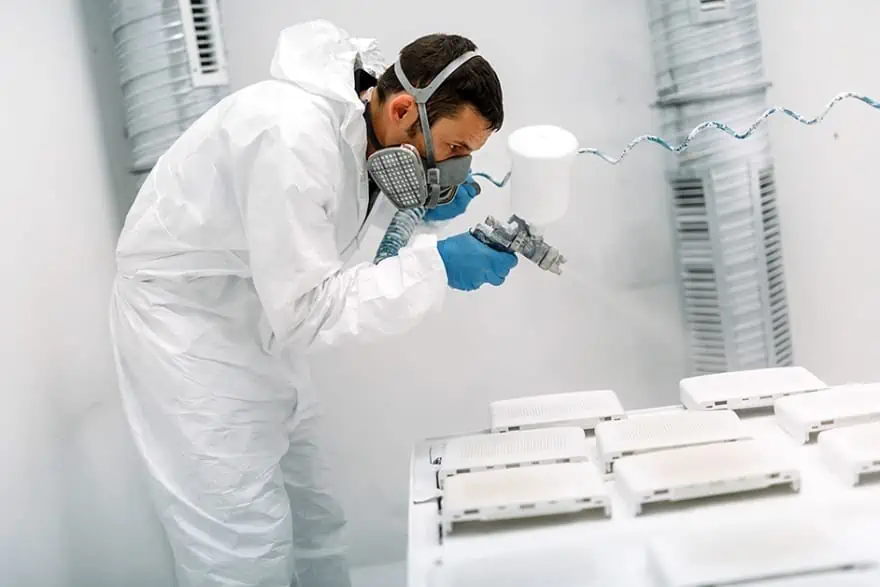
How to Put On a Half or Full-Face Respirator:
- Fix the respirator properly under your chin making sure the nosepiece is facing upwards
- Secure the top strap on the top of your head
- Secure the bottom strap on your neck
- Now adjust the facepiece as well as the straps until you have a comfortable fit
How to Put on a Dust or Filtering Respirator Mask:
- Take the mask in your hands making sure the nosepiece is toward your fingertips
- Secure the mask over your nose and mouth
- Secure the top strap over your head above your ears
- Secure the bottom strap below your ears on your neck
- If your respirator is equipped with a metal nosepiece use your hands to mold it securely to your nose
- Now adjust the facepiece as well as the straps until it fits comfortably
Performing a Negative Pressure Test:
- This is done to ensure the respirator seals properly over your face
- Put the palm of your hands over the cartridge openings
- Inhale slowly to let the facepiece collapse slightly
- Now hold your breath for about 10 seconds
- If you notice that the facepiece stays in that collapsed position, then there is no inward leak and the respirator is fitted properly
- If detect a leak you need to readjust the facepiece to make sure it seals properly against your face
Performing a Positive Pressure Test:
- Cover the exhaust valve with your hand
- Exhale slowly into the facepiece
- If you can feel a slight pressure building up inside the facepiece then the respirator is properly sealed
- If you detect a leak readjust the mask and repeat the process until you have a satisfactory seal
How important is the Maintenance of Your Respirator?
For your health and well-being, you need to take proper care and maintain your respirator regularly. It needs to be cleaned and sanitized after each use because a dirty respirator can result in solvents, isocyanates, and dust coming into contact with your skin. Again, check the manufactures instructions so that you clean and sanitize it correctly. This will entail you stripping the respirator and washing all the parts in warm soapy water after each use. Then rinse the parts in clean fresh water and allow them to dry before you reassemble them again.
For sanitizing you should once again follow the manufacturer’s instructions, however, you can use alcohol wipes to wipe the parts off. Then you need to place the respirator in a sealed plastic bag to prevent any dust or chemicals contaminating it. You need to check all of the filters regularly and if any are damaged or soiled, they need to be replaced. Never reuse an old damaged filter. If you notice strange tastes or smells, check your filters as they may be damaged. Select a dry cool place to store your respirator, as you do not want it to get wet or get moisture into it, which will result in it being unfit for use again.
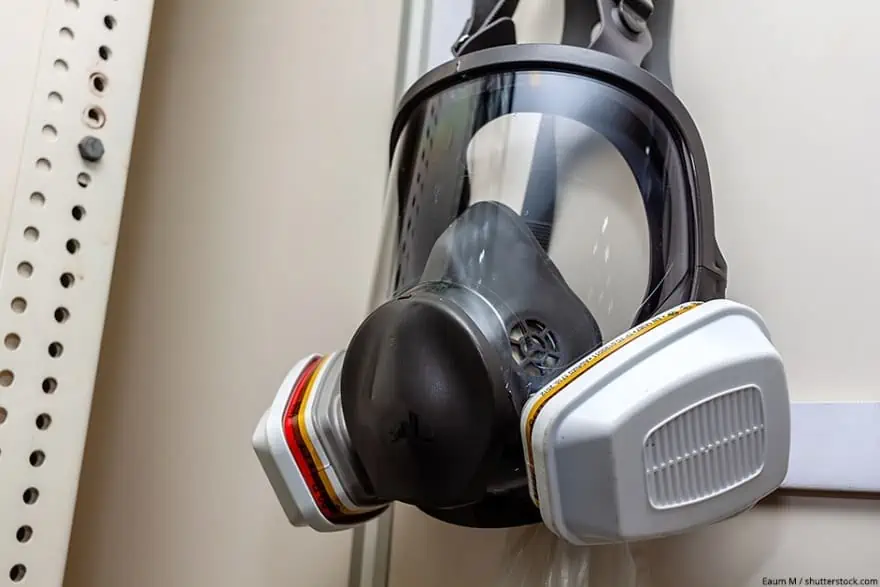
Frequently Asked Questions
Can You Use a Spray Painting Respirator for Sanding or Woodwork?
If you have bought a quality paint respirator, then it can be used for almost any job you are busy with. All you need to do is ensure you have the correct filters for the job you are busy with.
How Can I Choose the Right Size Respirator?
Most respirator brands come in small, medium, and large sizes. The small size is designed for use by children and also young adults. The medium size fits almost everyone, but they all have adjustable straps to ensure the mask fits tightly. However, if you find the straps have been adjusted to their limit and the mask is still loose or too tight, then downsize or upsize until you are satisfied with the fit.
When Should I Replace the Filters?
Most of the filters have a shelf life of around 5 years, but as soon as you have opened the packet the filters need to be changed every 6 months. But if you find a damaged or soiled filter, replace it immediately as it could affect the safety of your lungs.
What is the Best a Full-Face or a Half-Face Respirator?
This all depends on the type of elements you are going to encounter, as well as the specific level of protection you are looking for. If you are going to expose yourself to paint fumes, dust, or some other toxic substance, you can choose a half-face mask. However, if you are a DIY specialist or a professional and you need complete protection, including your eyes, from any harmful elements you are exposing yourself to, then you need to choose a full-face mask.
In 2005, Charlene completed her wellness degrees in therapeutic aromatherapy and reflexology at the International School of Reflexology and Meridian Therapy. She worked for a company offering corporate wellness programs for several years before opening her own therapy practice. In 2015, she was asked by a digital marketer friend to join her company as a content creator, and it was here that she discovered her enthusiasm for writing. Since entering the world of content creation, she has gained a lot of experience over the years writing about various topics such as beauty, health, wellness, travel, crafting, and much more. Due to various circumstances, she had to give up her therapy practice and now works as a freelance writer. Since she is a very creative person and as a balance to writing likes to be active in various areas of art and crafts, the activity at acrylgiessen.com is perfect for her to contribute their knowledge and experience in various creative topics.
Learn more about Charlene Lewis and about us.


